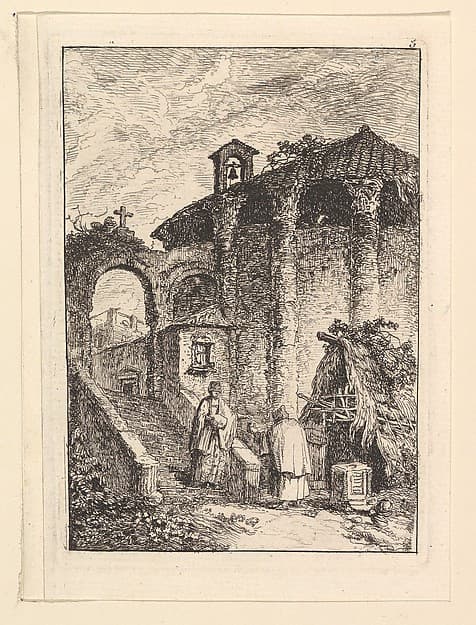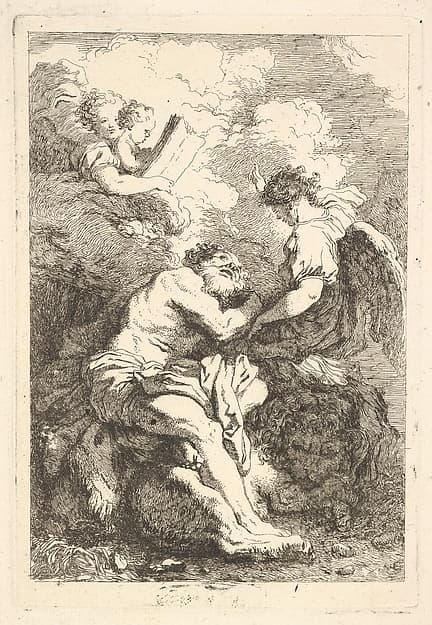
Related Artworks
Discover similar artworks

Ugolino
1860

Le Temple Antique
n.d.

Standing man with his right hand resting on a basin, shown in three-quarters view with his head turned toward the left, from "Figures of Fashion" (Figures de Modes)
ca. 1710

View of Imaginary Architectural Ruins
late 18th century

The Storm, after Greuze, from "L'Art"
1873

The Vision of Saint Jerome
ca. 1761–65

A Valet Putting Away the Luxious Clothes of His Master
mid to late 17th century

The Delights of Winter (Les Plaisirs de l'Hiver)
1759

La Course de Chevaux sur la Place Pitti a Florence (The Horse Race on the Piazza Pitti in Florence), from Les Caprices Series A, The Florence Set
1617

Christ Before Pilate, from "The Passion of Christ"
mid 17th century

Resurrection
n.d.

Man drinking from a pitcher
ca. 1640–70
More by Claude Gillot
Explore other works by this artist

Four Actors in Heroic Costume, with a Study of a Helmeted Head
ca. 1711–22

Design of a Flintlock, Side Plate, Butt Plate, and Trigger Guard, unnumbered plate from Nouveaux Desseins d'Arquebuserie Inventez et Gravez par Le Sr. Gillot
ca. 1715

Plate for The Fish and the Fireworks, Fable Sixteen, in Fables Nouvelles, Dediées au Roy
1719

The Education (L'Education): in a forest, to right an old satyr instructor holding a wand, teaching a group of children, to the left a merchant of orvietan trying to attract spectators with his act, from 'The lives of satyrs' (La vie des satyres)
ca. 1700–1720

Habit d'Ixion: a man wearing a tonnelet with a sword in the belt, a turban with one large feather on his head, from 'New designs for costumes' (Nouveaux desseins d'habillements à l'usage des balets operas et comedies)
ca. 1721

Habit de Roy: a man wearing a tonnelet decorated with rosettes, a crown and a turban with feathers on his head, from 'New designs for costumes' (Nouveaux desseins d'habillements à l'usage des balets operas et comedies)
ca. 1721

Plate 46: Habit de Folie: a woman in a ballet pose, wearing a bonnet and holding a marotte in her right hand, from 'New designs for costumes' (Nouveaux desseins d'habillements à l'usage des balets operas et comedies)
ca. 1721

The festival of Diana, interrupted by satyrs (Feste de Diane, troublée par des Satyres): nymphs gathered around the bust of Diana in a stone niche at center, surprised by the arrival of satyrs from either side, from 'Les Bacchanales; Quatres Festes'
ca. 1786

Witches' Sabbath, within a nocturnal landscape, a necromancer seated at top center wearing a robe and cap inscribed with Kabbalist symbols, below him to left a horse with the head of a beast, a ring of nude dancers to right, a robed with the head of a pig to left, various witches, sorcerers, strange animals, and monsters on the ground to left in the foreground, from 'The Sabbaths' (Les Sabbats)
ca. 1700–1720

The Birth (La Naissance): in a forest, the new mother resting in a hammock at center, the newborn below her to left, various satyrs and goats surrounding, from 'The lives of satyrs' (La vie des satyres)
ca. 1700–1720

The Marriage (Le Mariage): in a forest, an old satyr marries the betrothed in center, musicians to right, old satyrs with canes to the left, a couple consulting an old philosopher to left in the foreground, from 'The lives of satyrs' (La vie des satyres)
ca. 1700–1720

The Funeral (Les Obseques): various satyrs gathered in a clearing, funeral pyre to left, a freshly dug grave and a tomb decorated with satyr heads and antlers in center, upon which musicians are seated, from 'The lives of satyrs' (La vie des satyres)
ca. 1700–1720